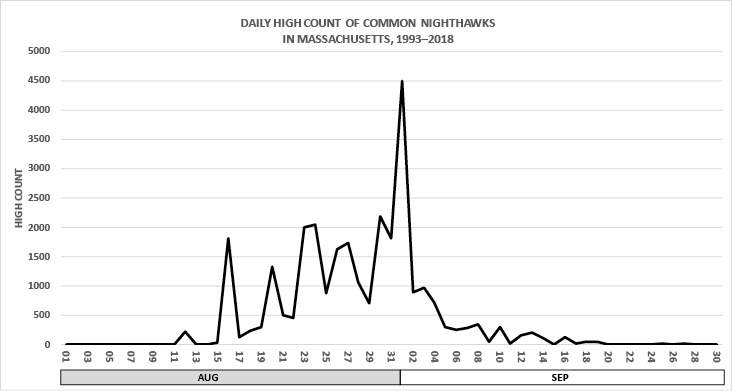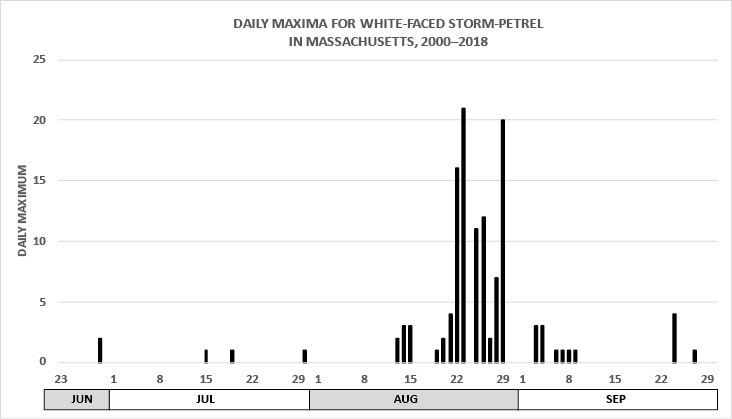Neil Hayward and Robert H. Stymeist

Figure 1. Fall migration of Common Nighthawk in Massachusetts. Daily maxima in August and September from 1993–2018. Data from eBird.org.
If you like heat and humidity, 2018 was your summer! It was the warmest meteorological summer (June-August) on record, surpassing the sweltering summer of 1983. The months of July and August were each the warmest on record for Boston. The summer was characterized by a seemingly persistent tropical air mass and dew points were above 70 degrees on many days.
The high temperature in Boston for July was 98 degrees on July 3, beating the record of 96 degrees set back in 1953. There were seven days in July in which temperatures exceeded 90 degrees. The average temperature was 77 degrees, three degrees above normal. Rainfall totaled 4.55 inches, 1.12 inches above the average for July. The highest one-day rainfall total was 2.68 inches on July 17. There was a flash flood warning for parts of southeastern Massachusetts and Rhode Island on July 6–7.
August recorded ten days of temperatures above 90 degrees. The highest temperature for Boston for the month was 98 degrees on August 29 and the average for the month was 77 degrees, five degrees above normal. Rainfall totaled 4.65 inches, 1.3 inches above normal. The weather made headline news in August when a tornado touched down in the towns of Dudley and Webster in Worcester County. Winds from the twister, clocking up to 110 mph, completely destroyed two buildings on Main Street in Webster. Other areas in central and eastern Massachusetts experienced torrential downpours with flash flooding.
R. Stymeist
WATERFOWL THROUGH IBISES
A Black-bellied Whistling-Duck was photographed at Westport at the end of July. This southern species has recently been increasing its range, and together with a propensity for wandering, has been turning up almost annually in the state since the first record in Ipswich ten years ago.
A Snow Goose was a rare summer sight in Hyannis for much of July and August. King Eiders were reported from Westport and Tuckernuck Island, only the second and fourth records this century for July and August, respectively. The family of Ring-necked Ducks in Royalston, the first documented breeding in the state since 1979, was doing well in July, although missing one of the original seven ducklings.
This was a good year for Pied-billed Grebes, which were recorded in seven counties this summer with breeding confirmed in at least two locations. Pied-billed Grebe is listed as endangered, together with eight other bird species, under the Massachusetts Endangered Species Act (MESA).
Common Nighthawks begin their southern migration in the last weeks of August, typically peaking around September 1 (see Figure 1). Over the past fifty years this goatsucker has been suffering a massive population decline. This year, however, brought a welcome respite from the bad news: Tom Gagnon, Northampton nighthawk watcher, reported the numbers this fall to be his third best for the past 44 years. It was also the first time he'd had back-to-back nights of more than 1,000 birds. A Chuck-will's-widow continued into July in Plymouth.
Fairhaven has become the go-to place in the state for rail watching. This summer allowed for a good comparison of the two large rallids, with a King Rail present throughout July and the first half of August together with up to two Clapper Rails. Clappers were also reported from nearby Westport and locations around the Cape. Common Gallinules were present at five sites, including an impressive six individuals at Monomoy.
Shorebird migration was well underway this period, including a couple of rare vagrants. A Common Ringed Plover, the fifth record for the state, was photographed and audio recorded at Monomoy on August 19. An adult Little Stint was also found at Chatham (July 31) and was also a one-day wonder. This bird represents the seventh record this century, all reported from Chatham during fall migration.

Figure 2. White-faced Storm-Petrel status in Massachusetts. Daily maxima from June–August 2000–2018. Data from eBird.org and Bird Observer.
A National Oceanic and Atmospheric Administration (NOAA) vessel passing through state waters in July and August logged a bounty of rarities. Goodies from the NOAA boat included: three Red-billed Tropicbirds; a Trindade Petrel (a potential third record for the state); two Black-capped Petrels; and a second-for-the-state Masked Booby. Anticipation was thus high for the overnight pelagic run by the Brookline Bird Club (BBC). After a year of weather-related cancellations, the group finally left harbor on August 25. Despite a lack of mega-rarities, solid numbers of deep-water species were recorded, including: 17 Band-rumped Storm-Petrels, 16 Audubon's Shearwaters, and a crowd-pleasing 25 White-faced Storm-Petrels. This overnight trip out of Hyannis has become the most reliable pelagic in the country to find this antipodean breeding species and the last week of August seems to be the best bet for seeing these birds in double-digits (see Figure 2). The trip also ran into an impressive four South Polar Skuas, two Long-tailed Jaegers, and a record fall count of 979 Red Phalaropes (beating the previous high of 550 from 2006, also set on a BBC August pelagic trip).
The highlight of the Laridae family this period was a Sandwich Tern photographed on Nantucket on July 28. Sandwich Tern is almost annual to our state, with the lion's share found in Barnstable County. This is the first record for Nantucket County since 2003. An impressive 24 Arctic Terns, all but one of which were immatures, were reported from Monomoy. After a bumper year for Brown Pelican sightings last year, a report of a bird flying past Eastham on July 29 was only the second for this year. A lingering White-faced Ibis photographed at Manchester is only one of a handful of July records.
N. Hayward
VULTURES THROUGH DICKCISSEL
A few dedicated hawk-watchers were stationed at Mount Wachusett in late August to welcome the first of the migrating hawks. Although few raptors are on the move during this period (the bulk of the Broad-winged Hawks typically appear almost a month later) two Northern Goshawks and 73 Broad winged Hawks were a satisfying introduction. Significantly out of season were at least four Snowy Owls that were found throughout July and August. The previous late date for this species was set at Logan Airport on July 7, 1990. This year probably also set a new record for Snowy owl viewing temperature: it was 98 degrees when a bird was spotted on August 29!
Breeding songbirds are still relatively active in early- to mid-July. For the past several years the South Shore Bird Club has conducted a Breeding Bird Survey at Quabbin Reservoir. This year the Club surveyed Gate 10 in Pelham on July 7 with some impressive numbers: 26 Veeries, 47 Ovenbirds, 20 Chestnut-sided and 22 Black-throated Green warblers, and 94 Red-eyed Vireos. The latter is the most abundant vireo in the state. In July, Mark Lynch counted 174 Red-eyed Vireos in Petersham, 141 in Sandisfield, and 131 in Royalston. Some of the more interesting breeding records this year included: a pair of Red-headed Woodpeckers in Manomet that fledged three young; and Blue Grosbeaks that successfully nested for the second year in a row at the Crane Wildlife Management Area in Falmouth. Purple Martins had another great year with 295 young fledged on Cape Cod. Mary Keleher reported 178 fledged from Mashpee alone, a significant increase from the 17 that fledged in 2008 when she first started working on Purple Martin conservation.
Fall migration is hard to miss in August when tens of thousands of Tree Swallows gather along our coasts. On Plum Island an estimated 150,000 Tree Swallows were noted on August 7. Some of the last migrants to arrive in the spring are the first to return south in the fall. Olive-sided and Yellow-bellied flycatchers share that distinction. Other early arrivals included a Canada Warbler on August 14, a Philadelphia Vireo on August 21, and a Swainson's Thrush on August 23. During this period a total of 29 warbler species were recorded, with the most notable being a Townsend's Warbler photographed on Nantucket on August 24. Other rarities during this period included a Western Kingbird at Gooseberry Neck in Westport (only the fifth August record for the state) and a Yellow-headed Blackbird also from Westport.
This year's Winter Finch Forecast, prepared annually by Ron Pittaway of the Ontario Field Ornithologists, predicts an irruption year in the east for winter finches. But we don't have to wait for the winter; we're already seeing the fallout of a poor seed crop in the boreal forests with increased numbers of Red-breasted Nuthatches showing up in late July. Purple Finches were also being reported in good numbers at the end of August, and as this report goes to print, Pine Siskins are starting to show up at feeders throughout the state. Red Crossbills were noted in several locations, mostly from Berkshire County in early July.
R. Stymeist